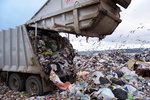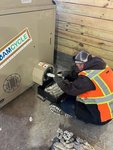

Gone are the days when downtown Durham emptied out after 5 p.m. Now, hip restaurants, boutique hotels and coworking spaces are big attractions, and downtown rocks into the wee hours many nights.
The city’s population grew by nearly 25% from 2010 to 2020, according to census data. The steady flow of construction projects near downtown Durham are producing taller and taller buildings by the week, it seems.
Nearly 302,000 people call Durham home as of Oct. 1, 2022, with an additional 49,000 people living in the county, according to numbers provided by the city of Durham’s Planning Department. Population growth at this level can come with a few downsides, such as traffic congestion, longer wait times to be seated at popular eateries — and more trash.
A lot more trash.
Durham’s landfill closed in 1997, so now the city sends its solid waste almost a hundred miles to the Sampson County Landfill. Trash collected from city and county residents, commercial haulers and contractors is brought to a transfer station on East Club Boulevard near the Interstate 85 interchange. There the trash is loaded onto large transport trailers and trucked to Sampson County, said Wayne Fenton, acting director of Durham's Solid Waste Management office.
“When you look at the demographics of the people who are negatively impacted by the trash we produce, it’s not an overstatement to say that everything we think is ‘getting thrown away’ is getting deposited in a low-wealth community,” said Crystal Dreisbach, founder of Don’t Waste Durham, a nonprofit organization whose mission is to eliminate waste.
Landfills can reduce the quality of life for people who live near them — they foul the air and produce greenhouse gasses, emit particulate matter and other toxins from garbage incineration, and generate emissions and noise as a constant flow of trucks haul waste five to six days a week. Though the sites are lined with a plastic barrier to prevent groundwater contamination, liners can tear and allow leachate to seep out and contaminate the soil, groundwater and wells.
So Durham, along with other municipalities in the state, is looking to reduce the amount of garbage it produces, with an eye to reducing costs and addressing growing health concerns around landfills.
Recycling: It’s complicated
Fenton said that on a daily basis, roughly 400 tons of trash leaves the Durham transfer station headed for the Sampson County Landfill. He also said that 12 to 14 tons of recyclable materials are transported each day to Sonoco Recycling in southeast Raleigh.
In 2022, the city of Durham was charged nearly $9 million for solid waste and recycling services provided by the landfill and recycling operators, according to information provided by Jim Reingruber, assistant solid waste director. The total includes loading, hauling, disposal, fuel and taxes.
Another part of that $9 million is the cost for the disposal of contaminated waste, which cost the city of Durham more than $56,000.
“(Contaminated waste is) anything that people put in the recycling cart that isn’t recyclable,”
Reingruber said in an email. “Bags cannot be processed, so bags and anything in them get screened out as contamination. That’s why it’s so important that people keep their recyclables loose in the cart.”
In 2018, the U.S. produced more than 292 million tons of municipal solid waste, or a daily average of nearly 5 pounds per person, according to the U.S. Environmental Protection Agency.
People may think that all those plastics in the trash are “going away,” but increasingly they’ve been entering waterways and foodstuffs and making their way into people as microplastics. A study found that 5 grams of plastic particles, roughly the weight of a credit card, are ingested by humans on a weekly basis, primarily in water or as part of fish, shellfish and other common food items.
While there is no known link between microplastic ingestion and disease in humans, a study published in 2021 found that people with inflammatory bowel disease had a higher quantity of microplastic particles in their feces than healthy people. (Crohn’s disease and ulcerative colitis are two forms of the disease.)
A call to action
In 2020, the U.S. recycling rate was 32%, but the country has a long way to go to meet the EPA’s goal of increasing that rate to 50% by 2030.
Cleaning up the recycle stream has become a focus of North Carolina lawmakers. Earlier this week at the General Assembly, Rep. Harry Warren, R-Salisbury, introduced a bill to reduce the amount of nonrecyclables in the waste stream.
Bills similar to the N.C. Managing Environmental Waste Act passed the House of Representatives in 2019 and 2021, only to die in the Senate.
Some key actions that would occur if the bill becomes law:
There is some objection to a part of the bill. Rep. Pricey Harrison, D-Greensboro, objected to language that seems to open the door for chemical recycling — a process in which plastic objects are exposed to high heat and chemicals, which break the plastic down to the polymer state in order to create more plastic — and that’s something that environmentalists and reuse-economy supporters say is a problem.
“I’m very skeptical of chemical recycling because it seems to be actually more toxic than other types of recycling,” Harrison said.
After the committee meeting, DWD released a statement that says, in part:
“The plastics industry is focusing on cities collecting more plastics as ‘recyclables,’ only to send them to ‘advanced recycling’ facilities that burn plastics either as fuel or to recover energy. … We are deeply concerned with the negative health, environmental, and environmental justice outcomes associated with this practice.”
But the solid waste industry is all on board with more recycling, more composting and reducing the load, as many municipalities are nearing capacity at the landfills they use, and no one wants a new landfill as a neighbor.
“Dealing with plastics is one of the hardest things that a local government and their private contractors have to do,” said Jack Cozort, a lobbyist for the solid waste industry. “Anything that helps us deal with the number of plastics that we have to deal with helps.”
The bill is still making its way through the legislative process.
Tools in use now show potential for boosting recycle rates. Currently, Henderson and Mecklenburg counties, UNC Charlotte and Greensboro are among an expanding group of North Carolina communities using a device to recycle polystyrene (PS).
Foam packaging material or to-go food containers, for instance, are fed into a foam densifier machine that heats and crushes the material, removing the air. Like toothpaste coming out of a tube, what’s left is extruded from the machine and stacked on pallets that can then be loaded and shipped to a buyer.
“We are very pleased with our densifier. It saves us so much space, and instead of spending money to recycle it (shipping) we make a little,” said Kelly Freshcorn, a recycling program associate at UNC Charlotte.
The foam that’s diverted from the landfill can be repurposed as insulation material and used to make picture frames, according to Lou Troiano, founder and CEO of Foam Cycle, the New Jersey-based company that manufactures the foam densifier equipment.
“Foam is one of these anomalies in the recycling world that is the most plentiful of plastic wastes but yet the least recycled,” Troiano said.
Adding a foam densifier is something that the city of Durham is investigating for the future, as well as other tools to help boost the recycling program.
But for now, Fenton wants to remind Durham residents that they should refer to the “Solid Waste Management” section of the city’s website if they have recycling questions. Most municipalities have similar information on their websites.
“We know that not everything that is recyclable from households is getting placed into carts,” Fenton said. “So if residents have a recycling cart, we want them to use it to the fullest and make sure that every can and bottle and piece of cardboard gets put in there, rather than some of it ending up in the garbage.”
This article first appeared on North Carolina Health News and is republished here under a Creative Commons license.
North Carolina Health News is an independent, nonpartisan, not-for-profit, statewide news organization dedicated to covering all things health care in North Carolina. Visit NCHN at North Carolina Health News.